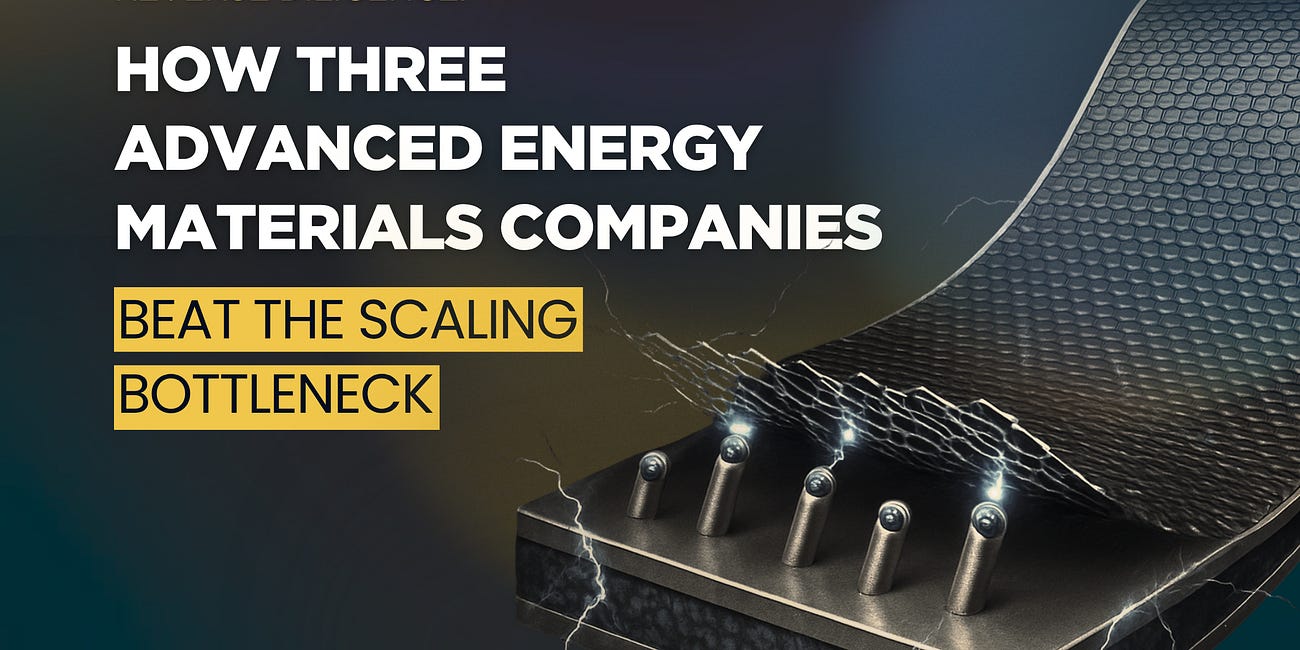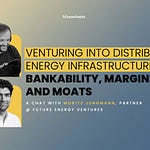Welcome to the 82nd edition of Deep Tech Catalyst, the channel by The Scenarionist, where science meets venture!
If you’ve ever dismissed fusion as a far-off dream—or wondered when clean, high-density energy will finally break through—this episode will reset your thinking.
Today, we’re joined by Julien Barber, Principal at Emerson Collective!
From milestone-driven roadmaps to full-stack integration, the race to commercial fusion is no longer theoretical. In this conversation, Julien shares why the physics is ready, what bottlenecks are slowing scale, and how capital, coordination, and culture will determine which companies survive long enough to make history.
In this edition, we explore:
Why fusion’s long-standing barriers are shifting—from scientific uncertainty to capital and coordination
How the fusion triple product offers clear KPIs for technical progress
Why Q > 1 is a market catalyst—not just a scientific milestone
Why vertical integration isn’t optional—and what that means for building fusion’s supply chain
Whether you're a founder tackling infrastructure-scale problems, an investor tracking deep energy tech, or just curious about the next exponential leap in power generation, this episode is your primer on fusion’s commercial moment.
Let’s dive in! ⚡️
✨ For more, see Membership | Deep Tech Briefing | Insights | VC Guides
BEYOND THE CONVERSATION — STRATEGIC INSIGHTS FROM THE EPISODE
Fusion Energy: A Contrarian Opportunity Ready for Commercialization
There’s a long-standing cliché in the energy world: “Fusion is always thirty years away.” It’s been repeated so often, and for so many decades, that it’s become more of a reflex than a real evaluation of the technology’s progress. But this view is increasingly outdated. The reality is that for the first time in human history, we’re approaching a point where commercial fusion power is within reach—not in theory, but in practice.
The Popcorn Analogy: Fusion’s Triple Product Explained
During the conversation, I loved one analogy: fusion is like making popcorn. To get that outcome, you need the right density of kernels, enough heat, and sufficient time for them to pop.
In fusion, the kernels are hydrogen isotopes. They must be heated to hundreds of millions of degrees and confined long enough for meaningful collisions to occur.
These three parameters—density, temperature, and confinement time—make up what physicists call the fusion triple product.
This framework has guided the field for decades. It defines the physical conditions required for fusion to occur and serves as a precise benchmark to measure progress. The challenge hasn’t been knowing the goal—it’s been figuring out how to reach it.
A Quiet Revolution in Progress
Since the 1950s, fusion researchers have been inching closer to those ideal conditions. What’s remarkable is that the data shows steady, compounding gains. In fact, when progress is plotted over time, fusion has advanced at a rate comparable to Moore’s Law—the exponential improvement that revolutionized computing.
Yet, unlike microchips, fusion’s trajectory has largely gone unnoticed by the public.
The result is a disconnect: from the outside, it still looks like fusion is stuck in the same cycle of promise and delay. On the inside, however, it’s clear that the field has reached an inflection point. The data is there. The technical milestones are within reach.
Market Timing Has Never Been Better
This technological readiness coincides with a powerful macro shift: the value of electricity has never been higher. Historically, an electron powered factories and homes.
Today, it powers AI training clusters, autonomous infrastructure, and hyperscale data centers.
Fusion fits this landscape perfectly. It offers a geographically flexible, carbon-free, base-load energy source—exactly what’s needed to support a digitally driven, decarbonizing economy.
And unlike fossil fuels or renewables constrained by geography or intermittency, fusion can, in principle, be built and deployed anywhere.
The opportunity is no longer about proving whether fusion works. The conversation has moved on. The real question is whether we can scale it fast enough to meet the surging demand of a $8 trillion energy market that is being reshaped by data, urgency, and industrial reinvention.
Reverse Diligence: How Three Advanced Energy Materials Companies Beat the Scaling Bottleneck
Amprius, Nexeon & Enovix: A reverse DD analysis of three real-world scale-ups on moats, capital discipline, and scaling advanced materials for next-generation high-energy-density electronics.
Capital, Coordination, and Culture: The Big Barriers to Commercial Fusion
Capital Is the First Bottleneck
Despite the excitement and real momentum in fusion technology, the biggest limiting factor right now isn’t physics—it’s capital. The field has reached a point where the core scientific breakthroughs have been made. The underlying principles are understood, and the technical path forward is increasingly clear.
What’s missing is the volume of financial support required to translate scientific potential into industrial-scale systems.
Ideally, that capital needs to come from both private and public sources. Large-scale fusion projects can’t survive on venture capital alone, but neither can they depend entirely on government support.
These efforts demand a hybrid approach: sophisticated private investment aligned with a long-term national or global industrial policy. Unfortunately, both types of capital are still too hesitant.
The capital vision—to allocate large sums into something as transformational but complex as fusion—has yet to match the moment.
This makes the capital stack itself one of the most immediate and solvable bottlenecks. The talent exists. The engineering capacity is available. Physics has matured. But the pace of deployment is being throttled by undercapitalization.
Unlocking more investment is not just a financial exercise—it’s the key to building working systems and accelerating time to impact.
Execution Requires Tight Interdisciplinary Coordination
Another core challenge lies in execution. Fusion reactors are arguably the most complex machines humans have ever attempted to build. These aren’t simple hardware systems or single-discipline projects. They demand a level of interdisciplinary integration that few other fields can match.
It’s not just about having a great plasma physicist or a strong mechanical engineering team. Fusion requires an orchestra of disciplines—thermal systems, structural mechanics, material science, cryogenics, power electronics, and even precision manufacturing. And all of those systems must be tightly coupled, interoperable, and engineered in parallel.
This kind of coordination doesn’t emerge naturally in early-stage startups.
Most technical founders are focused on proving an idea, not integrating an industrial supply chain. But in fusion, those steps can’t be decoupled. Teams must be ready to manage complexity early, often before the product exists, and long before the first customer arrives.
The stakes of getting this right are enormous.
Fusion companies typically raise hundreds of millions of dollars, much earlier in their lifecycle than software or materials startups. That means early-stage teams must quickly mature into organizations capable of leading major construction projects, recruiting across disciplines, and managing world-class execution risk. It’s not just hard—it’s culturally unfamiliar territory for most startup founders.
Resilience Is a Strategic Requirement
The final barrier is cultural, and it’s not often addressed explicitly: fusion is going to break things. It will hit walls—technical, organizational, and political—and often in ways that are demoralizing. That makes resilience not just a desirable trait, but a strategic requirement.
What’s needed is a culture that doesn’t fear failure, but rebounds from it quickly. This isn’t about optimistic storytelling. It’s about operational stamina. Teams need to run directly at the hardest problems, knowing that some will fail. Then they need to regroup, redirect, and try again—without losing morale or momentum. That’s the only way to move through the inevitable roadblocks on the path to commercial viability.
Creating that kind of culture starts at the top. Founders must model it, investors must reward it, and teams must internalize it.
In a field as difficult and groundbreaking as fusion, bounce-back ability isn’t optional—it’s a defining characteristic of companies that will survive long enough to make history.
Exits in Rare Earth Recycling Startups
3 Case Studies on How Exits Were Strategically Engineered Behind the Scenes.
Defining Milestones: From Pre-Seed Ideas to Q>1 Energy Gain
One of the most encouraging aspects of fusion, especially from an investor’s point of view, is that its development is unusually milestone-driven.
Unlike many emerging technologies where progress is vague or hard to quantify, fusion follows a well-understood sequence of technical thresholds. These aren’t arbitrary. They’re rooted in physics and measured with high precision. That makes it possible to evaluate whether a given project is truly advancing, or just telling a good story.
The core of this progression centers on the fusion triple product: the combination of plasma density, temperature, and confinement time.
These parameters don’t just indicate technical health—they define fusion’s very viability. And because this framework is well-established, startups can build clearly structured development plans that investors, partners, and regulators can follow.
From Idea to Plasma: The First Investable Milestones
At the pre-seed and seed stages, fusion projects often start with a small team and a promising approach. The earliest milestone is deceptively simple: can the system produce a plasma? It doesn’t need to be powerful or long-lasting, but it needs to be real and measurable. That first spark is often the earliest sign that the underlying architecture might work.
From there, the next goal is to produce a hot plasma, typically around 10 million degrees Celsius, or one kilo-electron volt (1 keV). This is more than just a demonstration of heat. It signals that the system can handle real fusion-relevant conditions.
At this point, startups are generally moving from seed into Series A territory.
But producing heat alone isn’t enough. The plasma must also be dense enough and confined long enough to approach the triple product threshold where fusion reactions start occurring. This level of performance often falls around the 10¹⁹ keV·s/m³ mark—a kind of industry-wide benchmark for serious systems. Crucially, this must be repeatable. One-off “miracle” shots don’t build power plants.
The Holy Grail: Net Energy Gain (Q > 1)
The critical turning point in fusion’s development timeline is achieving Q > 1, also known as net energy gain. This is the moment when a fusion system produces more energy than it took to heat the plasma—when the machine gives back more than it consumes.
This milestone isn’t just technical. It’s symbolic and catalytic. Once a private company reaches Q > 1, it will mark a profound shift in global energy innovation. A door will open—not just for that company, but for the entire fusion ecosystem. It will validate decades of research and unlock a wave of capital, talent, and industrial interest that has been waiting on the sidelines.
Public labs have already done this in tightly controlled settings.
In 2022, the National Ignition Facility used laser-based inertial confinement fusion to generate over twice the energy input—an achievement that has since improved to nearly four times.
But so far, no private fusion company has reached Q > 1. It remains the most eagerly anticipated milestone in the field.
Once it's achieved, the landscape changes overnight. Fusion will no longer be just a bet—it will be real, investable, and scalable. And while there are still major steps after that point, Q > 1 will be the inflection where scientific achievement becomes commercial momentum.
A Structured Path, Not a Mystery
What’s remarkable is that these milestones apply across a wide range of fusion architectures—from magnetic confinement approaches like tokamaks, to laser-based systems, to entirely novel methods. Regardless of technology, every viable fusion concept must pass through this technical gauntlet.
That makes it easier to align funding rounds with meaningful progress.
It also puts pressure on founders to stay rigorous. Overpromising doesn’t work in fusion. The physics won’t cooperate with hype. What matters is data, milestones, and the ability to move systematically from one threshold to the next.
Vertical Integration vs. Ecosystem Play: Building the Fusion Supply Chain
In most industries, specialization is the rule. Startups focus on their core innovation and partner with an ecosystem of suppliers, vendors, and manufacturing partners to handle the rest. In fusion, that model breaks down.
The challenge isn’t just that the supply chain is immature—it’s that the components themselves don’t yet exist in commercial form. These are first-of-a-kind machines, with first-of-a-kind subsystems, built with novel materials and unconventional engineering constraints.
That reality forces most fusion companies to vertically integrate far earlier than would be typical. They can’t afford to wait for a supplier to catch up—or take the risk that a critical vendor can’t meet spec. To move quickly and maintain control, they build almost everything in-house: magnets, vacuum systems, fuel injectors, power electronics, heat extraction systems, and more.
This isn’t a philosophical choice. It’s a practical one.
The underlying physics of fusion demands tight control over system performance. Tiny misalignments, inefficiencies, or timing mismatches can cause catastrophic losses in energy confinement or stability. The level of precision needed across the full stack leaves little room for coordination gaps between independent suppliers.
But for now, fusion startups must function like full-stack energy companies—designing, engineering, and assembling their entire product.
That level of integration comes with challenges: higher upfront costs, longer development cycles, and steeper operational complexity. But it also enables speed, coherence, and performance optimization—advantages that may prove decisive in a race to build the world’s first commercial fusion plant.
Energy Density and Economic Opportunity: The Long-Term Case for Fusion
To understand what fusion could unlock, it helps to look backward. For most of human history, energy came from burning biomass—mainly wood. That paradigm didn’t shift until the industrial era, when fossil fuels entered the picture. The jump in energy density from biomass to fossil fuels was about threefold. That relatively small improvement enabled the creation of the modern world: steam engines, manufacturing, automobiles, global logistics, and eventually the digital economy.
Fusion promises an increase in energy density of up to millions of times compared to fossil fuels. It’s almost impossible to overstate the implications.
Every technological leap we’ve enjoyed over the past two centuries—powered by oil, coal, and gas—was built on a fraction of the energy potential that fusion could deliver.
This isn’t just a scientific detail. It’s a foundational economic shift. Dense, clean, abundant energy unlocks capabilities we can barely imagine. From massively scaled AI to global desalination to interplanetary logistics, fusion gives us the raw power to think bigger—not incrementally, but exponentially.
A Future Measured in Possibility
All of this may sound like science fiction. But in reality, it’s just economics. Dense energy enables smaller plants, fewer materials, lower land use, and greater geographic flexibility. It creates a future where power isn’t a constraint—it’s a multiplier. And that changes how we think about infrastructure, computation, health, mobility, and industry.
The technologies that define modern life—from smartphones to satellites to AI systems—only exist because the energy infrastructure to support them existed first. If we invent a power source orders of magnitude beyond what we’ve had, the second-order effects could be revolutionary. It’s like asking someone in the early 1900s what digital streaming or genomic sequencing would be. We don’t fully know—but we know the direction is up and to the right.
Fusion’s potential is not just cleaner energy. It’s abundant, on-demand, carbon-free power that can be deployed anywhere on the planet. That means reliable electricity in remote areas, industrial heat for manufacturing, and backup power for critical systems. It’s a universal tool in the energy toolkit, unconstrained by sun, wind, or geography.
A Market That’s Already Here
Importantly, the opportunity isn’t theoretical or decades away. The near-term target is a global energy market worth around $8 trillion, spanning both electricity and heat.
Fusion can serve both.
Data centers, which are among the fastest-growing energy consumers, are already pushing grids to their limits. Industrial heat processes, which account for a significant chunk of global emissions, have few clean alternatives.
And perhaps most significantly, the value of an electron has never been higher. Historically, electricity-powered machines and homes have been. Now it powers intelligence, machine learning, automation, robotics, and scientific simulation.
Electricity has become the growth substrate for nearly every emerging technology. And in many areas, the lack of clean, reliable energy is becoming a limiting factor.
For the first time in history, fusion isn’t just a scientific goal—it’s a viable commercial pursuit. The technology is approaching readiness. The market is desperate for supply. And the macro tailwinds—from AI to electrification to climate urgency—are all pushing in the same direction.
What’s needed now is capital, talent, and focused execution. The window is open. Whether it stays open depends on whether we have the foresight—and courage—to walk through it.
When Niche Beats Scale: How Top-Tier Deep Tech Startups Thrive in Unsexy Markets
Power Laws and the Hidden Edge of Niche Dominance: 3 Real-World Case Studies.














